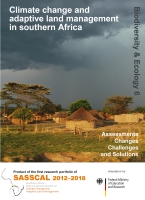
|

Department of Biology Institute of Plant Science and Microbiology |
| Division BEE > Biodiversity & Ecology > Vol.6 > Article 5.6 |
Biodiversity & Ecology
Journal of the Division Biodiversity, Evolution and Ecology of Plants , Institute for Plant Science and Microbiology, University of Hamburg.
Food security Research article Open Access Grain yield water use efficiency of cowpea (Vigna unguiculata L. Walp.) in response to planting dates in Botswana
Resumo: A África Austral é caracterizada por um elevado grau de variabilidade da precipitação, afectando a agricultura, entre outros sectores. A altura das chuvas mudou devido às alterações climáticas e prevê-se que a variabilidade será ainda maior. Isto ameaça a produção de grãos, a qual é dependente das chuvas. Logo, estratégias, tais como a escolha da data da plantação e a selecção da cultura com base na efi ciência do uso da água, poderão ajudar os agricultores a mitigar alguns desses impactos. Este estudo investigou o efeito das datas de plantação e diferenças genotípicas na productividade e efi ciência do uso da água do feijão-frade. Seis genótipos de feijao-frade foram plantados em quatro alturas diferentes (Novembro, Dezembro, Janeiro e Fevereiro). Os resultados indicam que o feijao-frade crescido em Janeiro utiliza quantidades moderadas da água disponível, produzindo maiores productividades médias, de 335,2Kg/ha, com uma efi ciência do uso da água de 3,72Kg/ha.mm-1. O BCA001 (Blackeye) exibiu a maior productividade e efi ciência do uso da água em todas as datas de plantação, indicando uma adaptação geral, enquanto que a variedade autóctone BCA019 (Speckled grey cowpea) tem o potencial de ser criada para a tolerância à seca e de ser lançada como uma variedade devido à sua precocidade e elevada efi ciência do uso da água.
Suggested citation: |
